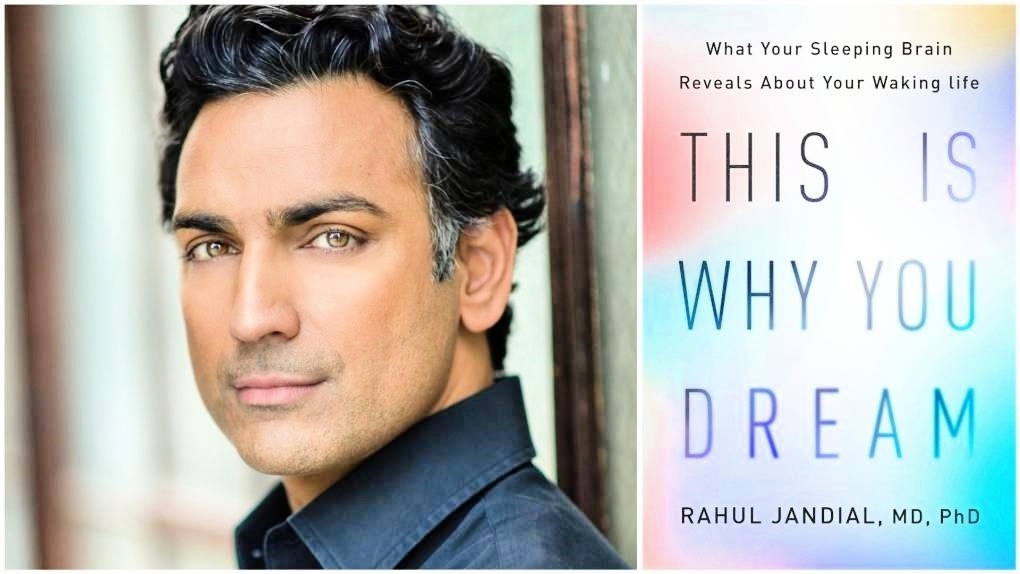Neurosurgeon and neuroscientist Rahul Jandial explores the science behind dreaming, arguing that dreams are not random noise but a vital biological process with evolutionary, psychological, and creative significance. He blends cutting-edge neuroscience with clinical anecdotes to explain why we dream and how dreams influence our waking lives.
CORE THESIS :
Neurosurgeon and neuroscientist Rahul Jandial explores the science behind dreaming, arguing that dreams are not random noise but a vital biological process with evolutionary, psychological, and creative significance. He blends cutting-edge neuroscience with clinical anecdotes to explain why we dream and how dreams influence our waking lives.
KEY THEMES AND TAKEAWAYS :
1. The Neuroscience of Dreams :
-
Dreams primarily occur during REM sleep, driven by heightened activity in the **amygdala* (emotions) and *visual cortex, while the **prefrontal cortex* (logic) is subdued.
-
The brain uses dreams to :
-
Process emotions* (especially fear and trauma).
-
Rehearse threats* (supporting the evolutionary "threat simulation theory").
-
-
Enhance creativity* (many artists and scientists have drawn inspiration from dreams).
2. The Purpose of Dreams :
-
Emotional Regulation:* Dreams help us work through unresolved feelings, acting as overnight therapy.
-
Memory Consolidation:* They sort and store important memories while discarding trivial ones.
-
Problem-Solving:* Some dreams offer novel solutions by making unexpected connections (e.g., Paul McCartney composing "Yesterday" in a dream).
3. Lucid Dreaming & Control :
-
Lucid dreaming (being aware you're dreaming) allows some people to *influence their dreams*.
-
Potential benefits :
- Overcoming nightmares (used in PTSD therapy).
- Practicing skills (studies show mental rehearsal in dreams can improve real-world performance).
4. Bizarre & Vivid Dreams :
-
The strangeness of dreams comes from the *brain’s storytelling attempt* to make sense of random neural firings.
-
Common dream themes (falling, flying, being chased) may reflect deep-seated fears or desires.
5. Dreams and Mental Health :
-
Frequent nightmares may signal *anxiety, PTSD, or neurological disorders*.
-
- Some dreams predict health issues (e.g., violent dreams linked to future Parkinson’s disease).
6. The Mystery of Precognitive Dreams :
-
Jandial acknowledges rare cases where dreams seem to predict future events but cautions against supernatural explanations.
-
Suggests these may result from the brain’s *subconscious pattern recognition* rather than true prophecy.
STRENGTHS OF THE BOOK :
✅ Engaging storytelling – Jandial uses patient cases and historical examples (like Lincoln’s assassination dream).
✅ Balanced science – Explains complex neuroscience in simple terms without oversimplifying.
✅ Practical insights – Tips on dream journaling and using dreams for creativity and emotional healing.
CRITICISMS (from reviewers & skeptics) :
❌ Some speculative claims (e.g., quantum brain theories lack strong evidence).
❌ Overemphasis on rare phenomena (precognitive dreams, telepathic dreams).
❌ Limited discussion of cultural differences in dream interpretation.
WHO SHOULD READ IT :
-
Dream enthusiasts curious about the science behind dreaming.
-
Psychology/neuroscience students seeking an accessible intro to dream research.
-
People struggling with nightmares who want science-based coping strategies.
FINAL VERDICT :
A fascinating, well-researched dive into why we dream—blending hard science with intriguing mysteries of the mind. While not every claim is rock-solid, it offers compelling insights into one of sleep’s biggest enigmas.
– Highly informative but occasionally ventures into speculation.
By Alhodhod, April 2025
